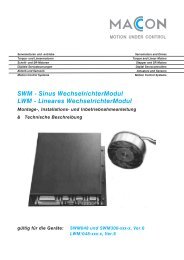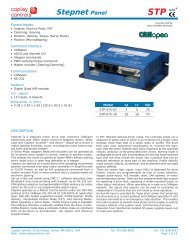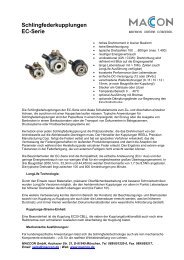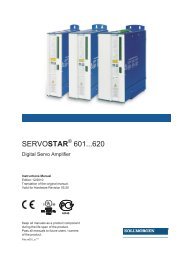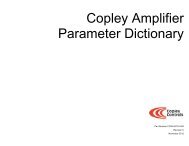CANopen Programmer's Manual - Maccon.de
CANopen Programmer's Manual - Maccon.de
CANopen Programmer's Manual - Maccon.de
You also want an ePaper? Increase the reach of your titles
YUMPU automatically turns print PDFs into web optimized ePapers that Google loves.
1: Introduction <strong>CANopen</strong> Programmer’s <strong>Manual</strong><br />
PDOs: Description and Examples<br />
Overview<br />
Each amplifier provi<strong>de</strong>s eight transmit PDOs and eight receive PDOs. A transmit PDO is used to<br />
transmit information from the <strong>de</strong>vice to the network. A receive PDO is used to update the <strong>de</strong>vice.<br />
Default PDO Message I<strong>de</strong>ntifiers<br />
The Communication Profile reserves four CAN message i<strong>de</strong>ntifiers for transmit PDOs and four<br />
i<strong>de</strong>ntifiers for receive PDOs. These addresses are <strong>de</strong>scribed later in this chapter (see Receive<br />
PDO Communication Parameters, p. 31, and Transmit PDO Communication Parameters, p. 35).<br />
The first four transmit PDOs and receive PDOs provi<strong>de</strong>d in Copley Controls <strong>CANopen</strong> amplifiers<br />
use these <strong>de</strong>fault addresses. The addresses of the remaining four transmit PDOs and receive<br />
PDOs are null by <strong>de</strong>fault.<br />
The <strong>de</strong>signer can reconfigure any PDO message i<strong>de</strong>ntifier.<br />
PDO Peer- to-Peer Communication<br />
Peer-to-peer relationships are established by matching the transmit PDO i<strong>de</strong>ntifier of the sending<br />
no<strong>de</strong> to a receive PDO i<strong>de</strong>ntifier of one or more other no<strong>de</strong>s on the network.<br />
Any <strong>de</strong>vice can broadcast a PDO message using one of its eight transmit PDOs. The CAN<br />
i<strong>de</strong>ntifier of the outgoing message matches the ID of the sending PDO. Any no<strong>de</strong> with a matching<br />
receive PDO i<strong>de</strong>ntifier will accept the message.<br />
PDO Peer-to- Peer Example<br />
For instance, No<strong>de</strong> 1, transmit PDO 1, has a CAN message ID of 0x0189. No<strong>de</strong> 2, receive PDO 1<br />
has a matching ID, as does No<strong>de</strong> 3. They both accept the message. Other no<strong>de</strong>s do not have a<br />
matching receive PDO, so no other no<strong>de</strong>s accept the message.<br />
PDO Mapping<br />
PDO mapping allows optimal use of the CAN message’s eight-byte data area.<br />
Mapping uses the SDO to configure dictionary objects in both the sending and the receiving no<strong>de</strong><br />
to know, for each byte in the PDO message:<br />
The in<strong>de</strong>x and sub-in<strong>de</strong>x which objects are to be accessed<br />
The type of data<br />
The length of the data<br />
Thus, the PDO message itself carries no transfer control information, leaving all eight bytes<br />
available for data. (Contrast this with the SDO, which uses one byte of the CAN message data<br />
area to <strong>de</strong>scribe the objects being written or read, and the length of the data.)<br />
24 Copley Controls






